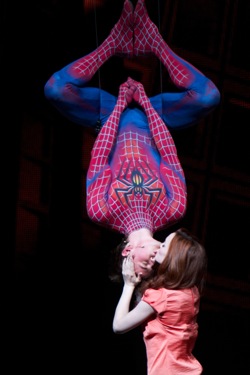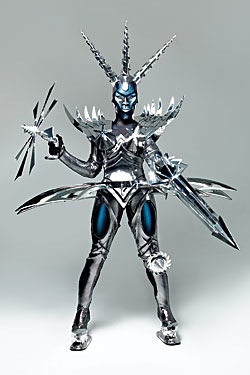After months of previews and ill omens, Spider-Man has
opened on Broadway, and it’s not that bad! For everything that this show does horribly wrong, it also
does something great. Spider-Man: Turn Off
The Dark has been reworked over the last few months, and while they didn’t
change the silly title, they have revised much of the script, the directing,
the music and lyrics. What’s good about the show comes late in game, and
it’s sad that people who flake out during intermission will miss all of the
fun. After a boring first act, and
some embarrassingly bad supervillains at the top of the second, Spider-Man
eventually swings his way to an amazing finale.
Holding back the first
act is that fact that it is yet another re-telling of Spider-Man’s origin, which
audiences already know from the movies, cartoons, and comic books. If it were being re-told well, this
wouldn’t be a problem, but Turn Off The Dark does two things that ruin Spidey’s
iconic origin tale. In every other version
of this tale, Uncle Ben dies because Peter refuses to stop a criminal who later
kills Ben. Peter is directly
responsible his Uncle’s death, and learns that “With Great Power Comes Great
Responsibility”. Here, that
wonderful line isn’t even spoken by Uncle Ben (A bit-player paraphrases it),
and Ben dies from a random carjacking that is completely unrelated to Peter.
In every other version
of this tale, Uncle Ben dies because Peter refuses to stop a criminal who later
kills Ben. Peter is directly
responsible his Uncle’s death, and learns that “With Great Power Comes Great
Responsibility”. Here, that
wonderful line isn’t even spoken by Uncle Ben (A bit-player paraphrases it),
and Ben dies from a random carjacking that is completely unrelated to Peter.
Then there’s Arachne, a
character from Greek mythology who has been awkwardly shoehorned into the
story. She was obviously heavily edited down from a previous version of the
show, and contributes nothing to the story but confusion. Plus she demands that the audience suspend
their disbelief about gods and magic, in a show that already requires the
audience to believe in science fiction concepts like super-powered mutations.
The pacing is terrible,
the show plods along with way too many subplots, until the Green Goblin
(Inevitably) appears at the end of the first act. When the second act does start, fans of the comic book are
in for an infuriating appearance by some Marvel villains. The Goblin creates six mutant henchmen
named after villains from the comic books. I say “Named after” because these characters aren’t actually
based on the characters at all. The backstories are completely re-written, they
have no dialog, and might as well be called Henchmen 1 through 6.
Then there’s the new
villain created just for this show, Swiss Miss, a robot drag queen with the powers
of a Swiss Army knife. She’s
certainly the most ridiculous villain that Spider-Man has ever fought, and I
say that in full knowledge that Spidey has battled Stiltman and a walrus guy. A huge problem here is that the script
repeatedly tells us that all of these villains are created by the Green Goblin
mutating the DNA of ordinary humans.
Which raises the question, just how does mutant DNA turn a human into a transvestite robot?
Far too much time is
spent with Spidey battling these inconsequential minions before he gets down to
fighting his true foe, the Green Goblin.
Here, halfway through the Second Act, the show finally comes together in
terms of superheroics.
Unfortunately, it never
really works as a musical at all.
The music isn’t bad, but it isn’t noteworthy either. There’s only one remarkable song, the
romantic ballad “If The World Should End” sung by Peter and Mary Jane. Much hype was put into the fact that it
was composed by Bono and The Edge (Now there’s a better name for our robot villain with knife
powers). But being a rock star is
not the same as composing musical theater, and they fail to distinguish
themselves here.
Visually the show is
very striking. The sets (George
Tsypin) are amazing recreations of iconic pieces of New York City for Spidey to
swing around in. The aerial work
(Scott Rogers) is incredible; a swarm of talented Stunt-Men swoop out into the
audience, battle the Goblin above the crowd’s heads, and swing through the
stage firing webs at villains. The
costumes are also great. Even
though I despise Swiss Miss as a character, I have to admit the outfit is one
of many impressive achievements for designer Eiko Ishioka.
Directing is a bit of a
problem, since the original Director Julie Taymor was dismissed, and this
version of the show is credited to Philip William McKinley as “Creative
Consultant”. It’s hard to tell who
to blame for specifics, but whoever was responsible for the mutant henchmen
screwed up tremendously.
Taymor surely deserves
blame for her contributions to the outright terrible book that she co-wrote
with Glen Berger. It was revised
by Roberto Aguirre-Sacasa, but it still needs significant editing, with Arachne
and the henchmen clearly needing to go.
The cast does what they
can with the lackluster material.
Reeve Carney is a charming Spider-Man/Peter Parker, and deserves extra
praise for doing much of the aerial work too. Jennifer Damiano is a sweet Mary Jane, playing the role for
all its worth, despite not having many interesting things to do. T.V Carpio clearly had her role as
Arachne slimmed down in the editing phase, but she makes do while dangling from wires, encased in a bug suit and singing
unremarkable songs. Villains
always get to do the fun stuff, and Patrick Page makes an amusing yet creepy Green Goblin
and Norman Osborn. Of course he doesn't become the
Goblin until Act Two, so he’s left with a couple of mediocre
songs in the first half of the show, but really takes off when he does his
villain routine with “A Freak Like Me Needs Company”.
I’m as jaded as they
come, but when Spider-Man swooped over the audience’s head and landed right in
front of me, I can’t deny it was an amazing experience. Despite many
missteps along the way, the show should leave audiences feeling satisfied.